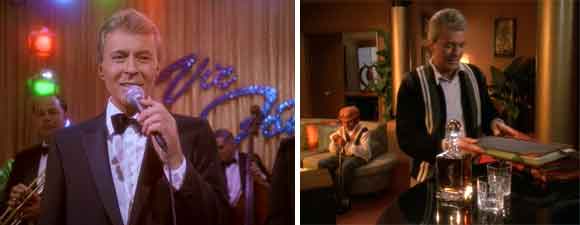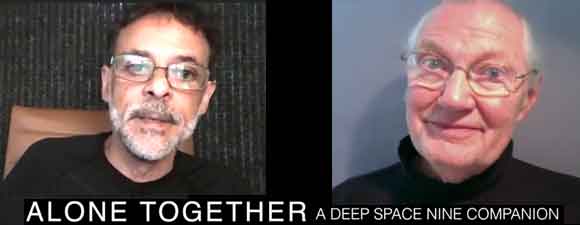Retro Review: In the Pale Moonlight
8 min readSisko decides to work with Garak to bring the Romulans into the Dominion War on the side of the Federation.
Plot Summary: As Sisko tries to log the events of the past two weeks, he can’t even remember the date. Things started to go disastrously wrong when he posted yet another casualty list, telling Dax that the only way the Federation could possibly defeat the Dominion was to bring the Romulans into the war on their side. Dax guessed that only proof of Dominion duplicity would persuade the Romulans to fight them, so Sisko asked Garak whether the former Cardassian operative could obtain documents about Dominion plans for Romulan containment. Garak literally met dead ends – his contacts were killed – but the shock when the Dominion subsequently invaded Betazed made both Sisko and Garak conclude that the Romulans had to be enlisted at all costs. Garak asked Sisko whether he would help to create fake evidence that the Dominion intended to betray the Romulans. Sisko logs that his conscience warned him against going too far, but his concerns about the fate of Vulcan, Alpha Centauri, and the rest of the Alpha Quadrant took precedence. He helped Garak get a violent holographic artist out of a Klingon prison and agreed to trade biomimetic gel for a Cardassian optic data rod, though he knew the gel could be used to create biogenic weapons. Garak’s ploy involved persuading the Romulan senator who negotiated the pact between the Romulans and Dominion of a planned invasion, so Sisko secretly lured Senator Vreenak to the station and showed him a forged Cardassian holorecording of Weyoun telling Damar of plans to surprise the Romulans with an attack. The Romulan quickly realized that the recording was fake, but when he left the station, his shuttle exploded. Sisko realized that Garak had only wanted Vreenak to visit the station so he could plant a bomb, making it look like the Dominion had sabotaged his shuttle and leaving just enough of the data rod to persuade the Romulans that Vreenak had discovered a Dominion invasion plan. Now the Romulans have declared war on the Dominion, and Sisko has come to the disquieting conclusion that Garak was right: the blood on his hands is a small price to pay for the safety of the Alpha Quadrant. He decides he can live with the guilt, and erases the log entry.
Analysis: “In the Pale Moonlight” is one of the best-produced episodes of Deep Space Nine – indeed, of Star Trek – but it’s deeply divisive, and for some fans it’s the moment when this series ceased to belong to the franchise, particularly coming just after the equally disturbing “Inquisition.” In recent weeks, we were told that the peace and security enjoyed by Federation citizens has always been safeguarded by a top-secret organization that answers to no one, but were still hadn’t been told much about Section 31, and misguided admirals trying to seize power in the name of peace were a problem in earlier incarnations of Star Trek. Sisko, however, is one of the show’s heroes, a Starfleet captain devoted to the ideals of the Federation and by extension to the ideals of the franchise. His acceptance of his role in a cold-blooded political assassination is chilling…I’ve met Star Trek fans who find it unforgivable. Kirk and Picard never did anything like it, with or without the sanction of Starfleet Command (which Sisko has when he puts the plot into play, and when Vreenak’s death creates an alliance between Starfleet and the Romulans, Starfleet asks no further questions about what Sisko did). I’m not sure that Spock wouldn’t see the logic of Garak’s scheme, for if the needs of the many indeed outweigh the needs of the few, the deaths of a few Romulans and a criminal wanted by the Klingons are mathematically a small price to pay to save millions of lives on Andor, Tellar, and all the other planets in range of the Dominion’s weapons. Yet Star Trek has always insisted on seeing even enemy combatants as individuals rather than numbers, and on attempting negotiations while avoiding violence at nearly any cost. Vreenak, his crew, and the forger Tolar are killed without any due process, without having committed war crimes. As Sisko says, these deaths are murders to which he is an accessory, but he’s willing to accept that judgment if it will save the Federation. The question becomes whether the Federation is worth saving, for when the rights of citizens can be violated within the law by Section 31 while the rights of non-citizens are trampled by Starfleet, how is it better than the star empires and syndicates around it?
I’m certainly not one to argue that I’d rather live in the Klingon Empire or on Ferenginar, where as a woman I’d have fewer rights by definition than men do, nor that I’d prefer the twisted Romulan version of Vulcan logic, nor “peace” established by the Founders within the Dominion. What would Roddenberry do? In the face of an invasion by a stronger enemy who will accept negotiation only under terms of surrender, we don’t have an answer. It’s not a problem we ever saw Kirk or Picard face for more than a couple of weeks at a time. We know that Kirk was comfortable bending or breaking the rules, even the Prime Directive, when he felt that it was necessary for the greater good; as he said himself, he never really faced death until he lost Spock, he just found ways to cheat it and congratulate himself for his ingenuity. Picard did face a massive threat to the Federation and was even made complicit in it when the Borg took him over, but he, too, figured out a cheat, a way to shut down the enemy’s invasion force that makes them self-destruct due to a flaw in their own machinery. Sadly, no one has found a way to cheat against the Dominion, which means that when the Dominion brings war to the Alpha Quadrant, allied with a vicious, self-serving Cardassian government that’s even more intractable than the Klingons were in the old days of hostilities, the only choices are to fight them or to do what Bashir and his band of geniuses proposed: to surrender and accept living under Dominion rule. Is it possible to fight fair against people whose leaders can shapeshift and take over key positions, who genetically engineer strategists and soldiers to be more easily replaced and physically stronger than any in the Federation…who are, in other words, already cheating according to the standards adopted by Starfleet? Probably not. So the real question isn’t whether this war story violates Star Trek’s ideals and principles, but whether such a war story can be told in that paradigm without betraying either realism or Roddenberry’s dream of a universe where intelligence and empathy trump selfish motives like greed and the desire for self-protection.
I love that DS9’s writers had the courage to go here, because it was always a source of frustration to me that we never really saw how we got from a world that produced Khan and the post-apocalyptic nightmare that Q showed Picard to the wonderful future of the 23rd century. We’re forced to think about the progression, not only in episodes like “Past Tense” and “Necessary Evil” which confront how the Earth and the characters became the forces for good that we now see, but in stories that remind us of all the things that can go wrong even when it looks like people have worked out the enormous problems of hunger, disease, distribution of resources, and all the rest. “In the Pale Moonlight” is primarily about how little Sisko wants to have to make the choices that lead to the result everyone desperately wants, the Romulans joining the Federation in fighting the Dominion. He spends the entire episode agonizing over how he’s justified them to himself. Yet his self-recrimination seems overstated next to his grief at the mounting casualties in a war that has not seemed nearly significant enough in the weeks leading up to these events; I have trouble believing that he’s really angry at Garak or himself over the deaths so much as over his being forced to admit that Garak is a much smarter wartime strategist for precisely the reasons Sisko has resisted liking and trusting Garak. He says when Garak asks if he’s prepared for a bloody business that the war has already involved him in one. A Starfleet captain who’ll risk trading material that could create bio-weapons (over the objections of an overly sanctimonious Dr. Bashir) can’t be that devastated over the deaths of a bunch of Tal’Shiar operatives working for the destruction of the Federation and a criminal the Klingons were planning to execute anyway. Sisko has personally shot at more enemy combatants than died to bring the Romulans to war against the Dominion. And Garak’s math is flawless, sacrificing a tiny number of people to save millions. Until Sisko punches him, he’s even willing to carry the responsibility for the deaths without requesting or getting any glory for his machinations.
Avery Brooks gives one of his best performances in this episode, though I can’t think of a Captain Sisko-focused episode in which he isn’t terrific. He has to hold the audience’s attention for long minutes at a time with nothing but his voice and facial expressions, and he is riveting. The unconventional script and directing, which allow Sisko to soliloquize and address the camera directly, work very well for this story in which the tension is largely internal. Considering that the material is fairly depressing and the sets quite dark, there’s a surprising amount of levity (the Rule of Acquisition about every man having his price, “the souffle will either rise or it won’t and there’s not a damn thing you can do about it”), and the tension is palpable despite the prior knowledge that whatever has happened, it hasn’t broken Sisko. Because of the Romulan ship in the hangar, I’m not positive “In the Pale Moonlight” counts entirely a bottle show, but it’s almost entirely on DS9 sets, meaning that most of the visual interest comes entirely from the acting and the dialogue. No matter how one feels about the changes to Star Trek brought about by the Dominion War, the production values are exceptional, the performances unforgettable. Count me with the fans who think this is one of the series’ finest moments.







Signs and wonders. The first time that I can agree with you on practically every level.
Super review! And I do think it’s a bottle show.
Vic ruined it, he’s a slimeball.
In some ways this is better than a true bottle-show. This is a show one could do set-less. You could have Brooks on a bare stage dictating his log entry, then stepping from one spotlight to another to have the conversations that represent what he’s logging about. You could ALMOST do this as a one-man show, actually, because a man like Brooks is versatile enough to believably carry almost all the parts–but then you’d miss out on the equal brilliance of Andrew Robinson as Garak.
Star Trek has always, IMO, been about one of two things: 1] The Future is Awesome or 2] Sometimes you have to fight to KEEP the future awesome. This is 100% the latter. Would Roddenberry have approved? Impossible to know, but my opinion is that late-60s Roddenberry would have approved, but that possibly late-80s Roddenberry might not have. But I’m not positive even of that. Roddenberry’s cardinal rule for TNG-era Trek was that HUMANS should not be in conflict with each other, that not just Earth but all humanity was somehow Utopian. This is one of the reasons DS9’s cast is so weighted toward the alien — so that interpersonal conflict could be brought back to the core cast.
Personally, I could see Shatner/Kirk in this exact same position and role. If the Organians had not intervened and the Klingon war had broken out hot, as it looked like it would in “Errand of Mercy”? I totally could see Kirk pulling something like this to secure an ally…
The comfortable old Man-Hating Happy Zone briefly beckoned her in the second paragraph, but otherwise yes.
The line that best signified one of the major themes of Deep Space 9 was, “It’s easy to be a saint in paradise.” That statement was best illustrated in this episode, “Inquisition” and “The Maquis”.
That take on late-model Roddenberryism was a big part of what made DS9 such a remarkable show. By the ’80s, Gene had gone off the deep end creatively. His New Frontier humanism of the ’60s had evolved into a preposterous notion of Perfectible Humanity that made for a pretty bizarre first season of TNG, in which characters enjoyed the fruits of a perfect, peaceful, want-free society that they had done nothing to build, and from the perch of which they frequently looked down their noses at their forefathers who had (1st-season Picard was the worst in this regard). The show dropped this attitude as Gene stepped away from it, instead settling into a comfortable vanilla-ness it never did fully shake off.
DS9 understood what Picard never did — that it is, indeed, easy to be a saint in paradise. It honored Roddenberry’s dream of a human race that could make peace with itself — that was, as he once put it, “really something” — by being honest about how hard-won a prize peace is. Picard is an explorer, but Ben Sisko is a builder.
The idea that being critical of patriarchal values is tantamount to manhating is risible.
You’re obviously not a regular reader of these.
I will never forget the first time I saw this episode. I was spellbound. When it was over, all I could say was…”wow!”; Brooks and Robinson were both riveting.
I’m surprised she didn’t mention the episode’s “sernnot jies”. Am still waiting for an explanation of what that is…